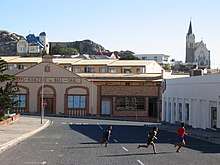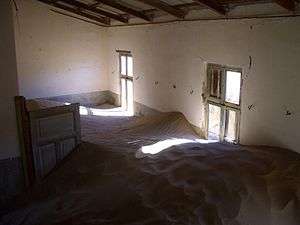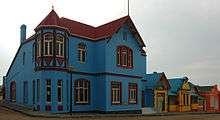Lüderitz
Lüderitz is a town in the ǁKaras region of southern Namibia, situated on the coast of the Atlantic. It is a former colonial German town, noted for its distinctive German atmosphere and colonial style buildings, reflecting the Art Nouveau style architecture at the turn of the century. Lüderitz experienced its major rise and fall during a short diamond rush in the early 20th century. As a result many of the historic buildings are still in their original, today often dilapidated, state. After a major renovation of the waterfront, residents now hope for a renaissance.

Understand
Geography
There are three entities called "Lüderitz" today: The town itself, the peninsula to its south-west, and the ocean bay.
History
Portuguese Bartolomeu Dias landed in the Bay in 1487 and erected a cross on the peninsula, a replica of which still stands. The richness of marine life was discovered in the early 19th century, and Lüderitz became a trading post for guano from the penguin colonies on the islands nearby.
Being the only natural deep-see harbour at the time—Walvis Bay was under British control—merchant Adolf Lüderitz obtained the Bay and the land around it in 1883. The deal was not quite fair as the contract stated geographical miles (7.4 kilometres (4.6 mi)) as the measurement while the only locally known unit was the English mile (1.6 km). The Frederiks clan thus lost most of its land to the Germans, making way for the establishment of German South-West Africa.
In 1909 diamonds were discovered on the railway track through the desert, and a diamond rush began. It lasted until 1920 when the new South African-run government declared all of the land around the town a forbidden zone, terminating almost all private mining activities. Business activities ceased, and the town fell into decline. The Sperrgebiet still is in place today; when travelling to Lüderitz, no matter the direction, you may not leave the road.
Get in
By car
Lüderitz is 350 km west of Keetmanshoop along a tarred road, the B4, via the hamlets of Goageb and Aus. If travelling by road you have the choice to get into fog (from dusk till dawn) or into a sand storm (over the day). Adapt your speed to visibility. There are always heaps of sand on the tarmac, like mini dunes piled up by the wind. Driving over them at speed is comparable to hitting a brick wall.
By train
- 🌍 Lüderitz Train Station. Although Lüderitz has a train station, there are no scheduled train services on this line. The rails to Keetmanshoop are operational and charters are possible.
By plane
- 🌍 Lüderitz Airport (LUD IATA). regular service to the capital Windhoek, and to Cape Town in South Africa.
Get around
By rental car
- Badgers Car Hire, ☎ +264 63 20-2334.
There are several tour operators in Lüderitz which will also take you to some of the areas attractions. There are several standard car rental agencies in town which will enable the tourist to see the Lüderitz Peninsula, including Diaz Point, Agate Beach and some of the bays teeming with flamingos.
See
.jpg)
There are many historic German colonial buildings including the Deutsche Afrika bank building, the Station building, the Old Post Office, and the small Felsenkirche (the church on the rocks), a Lutheran church. One of the most notable buildings is the Goerke Haus at the end of Zeppelin Street. This is one of Lüderitz's best preserved buildings, considered one of the "diamond palaces". Other buildings of note are Troost House, Kreplin House, Krappenhoft and Lampe building, Woermann House and Turnhalle.
Located south-west of town, Lüderitz Peninsula is criss-crossed by 4x4 tracks and small roads. The major attraction, the replica of the cross erected by Bartholomew Dias in 1487, is reachable via District Roads but many of the tracks to minor destinations are not passable with a sedan, including the majority of the bays, and the "Kleine Bogenfels" (Rock Arch Minor) rock formation. Visit the breeding ground of the endemic Damara Tern, several bays teeming with birds, and (with good binoculars) the penguins on Halifax Island.
Do

Town walking tour
The historic town architecture is a mixture of German Imperial Style and Art Nouveau. These are best seen on foot, a short walk through the town. Visit the buildings noted above.
Halifax Island
The Penguin and Zeepard (sea horse) catamarans drive daily to Halifax Island, home to one of the few colonies of African penguins. Flamingos and seals can be spotted on tour, and a few dolphins usually chase the boat. Wear a windbreaker, even in summer, as the mornings out on sea can be very chilly. The catamarans depart from the Waterfront jetty at 8AM, adults N$450, one child free for every paying adult, otherwise half price (Jan 2018). This must normally be paid one day in advance at the information office (Lüderitz Tours & Safaris in Bismarck Street, Tel 202719) downtown. However, if the catamarans have space—they usually do—you can just come to the jetty and pay cash.
Kolmanskop
Do visit the nearby ghost town of Kolmanskop. It is no longer signposted (January 2018) but easy to find. Drive out of town for about 8 km on the B4 and for the settlement on your right, just by the airport. Founded in 1908, it was a major settlement for diamond miners until richer ore and alluvial deposits were found near Oranjemund. The town boasted unbelievable wealth during the heydays of the diamond rush. Tabs in the Casino were occasionally paid in uncut diamonds, or diamond mining company shares. Kolmanskop had a tram, the only one in Africa, transporting passengers and delivering free ice blocks to re-stock private fridges. The clinic has an X-ray machine, likewise a first in Africa, but the reason was less charitable: workers were X-rayed for swallowed diamonds, and the clinical advantage of the device was only of secondary importance.
The last settler left in 1956, giving the town over to the sand dunes that have crept in and started to take over the town. It is one of Namibia's premier ghost towns. There are one-hour guided tours daily in the mornings at 9h30 and 10h45. Photographers can book special tours during sunrise when the scenery is particularly spectacular. Permits are required and available at Lüderitz Tours & Safaris in Bismarck Street, Tel 202719, as well as at the gate to Kolmanskop.
When you do the German-language tour, the guide will tell you that the Namibian government has struggled for over a decade to rebuild the railway from Keetmanshoop to Lüderitz, and as yet without success, while the Germans more than 100 years ago had done it in ten months. What they are not telling you is that the four thousand workers were inmates of various concentration camps, and in Lüderitz alone (on Shark Island) at least a thousand of them died. However, don't discuss that with strangers, or you might end up in a fist fight.
The souvenir shop in the old Casino hall stocks Namibian diamonds, reportedly for a very good price. There is also a bistro. The original skittle alley can be booked for special occasions, it is still fully functional.
Bogenfels
The tour to Bogenfels arch passes the diamond ghost towns of Elisabeth Bay and Pomona. Apply well in advance, as the necessary permits to visit the restricted diamond area take 4-5 days to process. The tour operator provides the 4x4 as own vehicles are not allowed on this track.
Shark Island
Shark Island is situated in the Lüderitz Bay circa 2 km from the city centre. It is used as a camp site but you may walk around without being a patron. The Germans used it as a concentration camp during their colonial expansion in the late 19th century. Until today, few Namibians know how to swim, and the sea is quite rough here. All that had to be guarded was therefore a small sand bank connecting the island to the town.
The small monument pointing out this dark spot of history has been removed but there are a number of plaques and shrines memorializing major and minor events of the island and of the town. There is a grave stone of the Frederiks clan which lost over 100 members to the Germans in this camp, and there is also a plaque for Brazilian navigator Amyr Klink who in 1984 rowed 7,000 km over the Atlantic, starting off here.
Buy
Fish is the best thing available.
Eat
Seafood is a speciality of the area. Lüderitz is a centre for rock lobster and oysters, and holds an annual crayfish festival.
- 🌍 Essenzeit, Waterfront, Hafen Street (upstairs). Food is not bad but not stellar, either. Try the snails for starter, they're delicious. Starters 60 N$, Main courses 130 N$.
- 🌍 Nicky's Bistro, Waterfront, Hafen Street (downstairs). Simple eatery, the fish is fresh, and the staff is friendly. Try the fish fingers, they're home-made. 40-70 N$.
- Captain Makarena, Waterfront, Hafen Street (one of the small shops in the mall). Actually just a food stall with a single bench in front. You'll have to eat from the paper packaging and without cutlery but compared to the restaurants in the vicinity, the fish here seems to be the freshest and tastiest. Invest a few N$ and order kingklip instead of the ordinary hake. 40-80 N$.
Drink
Windhoek Lager Beer, brewed in Windhoek. Brewed according to the German Beer Purity Law, it's the best beer you'll find in southern Africa.
Sleep

There are several hotels plus several guesthouses and a backpackers hostel.
Budget
- 🌍 Luderitz Backpackers, no 2 Ring street, ☎ +264 63-202000. Camping/dorm beds. N$70/100.
- 🌍 Shark Island camp site (follow the signs from the city centre). Shark Island is idyllic but two features potentially spoil the camping experience: First, it is a former German concentration camp (specifically, a death by slave labour camp) – spending the night alone at this place might be spooky for many people. Second, the peninsula is completely exposed to the wind. Pitching a tent at a place where you could not hold an umbrella due to wind speed, is a formidable challenge. N$100.
Mid-range
- 🌍 Obelix Guest House, Woermann Street. Very friendly staff, and a beautiful breakfast room. Single room 495 N$, Double 750 N$, Family room 1,070 N$, kids 12 and under sleep free.
Splurge
- Kapps Hotel, ☎ +264 63 20-2345, fax: +264 63 20-3555, e-mail: pmk@mweb.com.na.
- 🌍 Lüderitz Nest Hotel, ☎ +264 63 20-4000, fax: +264 63 20-4001, e-mail: reservations@nesthotel.com.
Connect
The area code for Lüderitz is 063. There is cellphone coverage in town and along the main road, both from MTC and Telecom.
Go next
This town can be very windy. Particularly at the end of December through the middle of February, the wind can be quite substantial. Watch out for small sand dunes on the B4 that pile up all the time; any one of them, however small, is comparable to a pile of bricks when your car hits it.